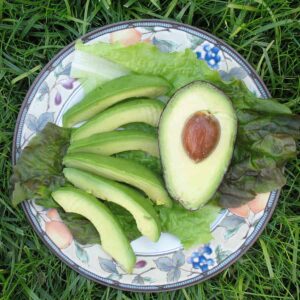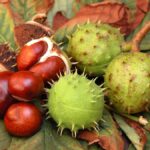Avocados have a rich buttery textured flesh with a slightly nutty flavor and can be eaten as a vegetable or a fruit. Avocadoes are usually eaten raw. They do not cook well.
- Add avocado slices to sandwiches and salads and to hot and cold soups.
- Avocado halves can be stuffed with seafood or chicken.
- Slice avocado and add to sauteed fish or chicken dishes before serving.
- Make guacamole by crushing firm avocado with lime juice, onion, tomato, chilies, salt, and cilantro.
Favorite avocado recipe
Avocado flavor partners
Avocados pair well with chiles, cilantro, crabmeat, grapefruit, lime, shrimp, tomato, tropical fruits, turn, and vinaigrette.
Types of avocados
There are dozens and dozens of avocado varieties spread around the world. Here are three original forerunners or races of the avocado species:
- Mexican-type avocados are plum-sized, smooth-skinned, and purple or black-colored fruit that matures in autumn. The varieties “Bacon” and “Mexicola” are Mexican-type avocadoes. These are hardier than the other types. They are oval and have thin, green, glossy skin.
- Guatemalan-type avocados bear larger fruits, have rough skins, and their color varies from green to purple to black. The fruit matures in spring or early summer and stores well. “Hass”, “Gwen”, “Nabal”, and “Pinkerton” are Guatemalan-type avocadoes
- .West-Indian type avocados have a very large fruit of up to 2 pounds (1 kg) or more with smooth skin. They are usually light green and of medium thickness.
The avocado “Fuerte” is a Guatemalan-Mexican hybrid. “Zutano” is another popular hybrid.
Avocado harvest times
There are two avocado harvests every year: from November to March and from September to October. Winter harvest avocado varieties are ‘Bacon’ which is similar in size and color to ‘Fuerte’, and ‘Pinkerton’ which is larger. Summer harvest avocados include ‘Hass’ during the summer.
Avocadoes come in varying shapes, colors, and sizes depending on the variety. There are those that stay green when ripe, like ‘Fuerte’, and those that turn black at maturity, like ‘Hass’.

How to choose an avocado
Select avocadoes that are heavy for their size, not too hard, and free of blemishes. An avocado is ready to eat when it yields to the touch but is not soft. Avocadoes that are too soft will be overly ripe. Overripe avocado flesh will be brown and stringy.
It is best to buy avocadoes a few days before you need them. An unripe avocado will ripen in 4 to 7 days at room temperature.
How to store avocados
Store unripe avocadoes at room temperature until they ripen. To speed ripening store an avocado at room temperature wrapped in a newspaper or in a closed paper bag pierced with small holes to allow gases to escape. Once ripe, the avocado will keep in the refrigerator for a few days.
How to prepare avocados
Cut the avocado in half lengthwise. If the flesh clings to the pit, twist the two halve gently in the opposite direction. Then the pit can be removed with a knife or with a spoon.
To make removing the peel easier, cut the avocado in half, remove the stone with the skin still on, cut through the flesh and the skin to make slices. Then strip off the peel.
Avocado flesh will darken when exposed to the air. To prevent discoloration, sprinkle the flesh with lemon juice or vinegar.
About avocado
Botanically avocado is a fruit, but it is eaten as both a fruit and a vegetable.
Most avocadoes are pear-shaped but some are round. An avocado tree, which is a tropical or subtropical evergreen, can grow to 40 feet tall. Its leaves are waxy and oval.
The avocado is native to Central and South America where it has been cultivated for at least 7,000 years.
The word avocado comes from the Aztec word abuacatl which is roughly translated as “testicle”. The reference is undoubtedly to the fruit’s pear shape. Spanish explorers took the avocado to Europe in 1527. There the Aztec word abuacatl was said to be unpronounceable and became ahuacate or aguacate and was further modified to the pronounceable “alligator” and to “avocado” in California in 1915.
Avocadoes are also called “alligator fruit” and “butter pear”, a reference to the consistency of their flesh.
The botanical name for the Guatemalan family of avocados is Persea americana. The botanical name for the Mexican family of avocado is Persea drymifolia.
Also of interest:
How to Plant, Grow, and Harvest Avocados
Articles of interest:
Best Herbs for Container Growing
Garden Planning Books at Amazon:
- Vegetable Garden Almanac & Planner
- Kitchen Garden Grower’s Guide Vegetable Encyclopedia
- Vegetable Garden Grower’s Guide
- Tomato Grower’s Answer Book
More kitchen tips:
Bring your harvest to the table. Kitchen prep tips and easy recipes for the vegetables you grow. Click below for vegetable prep and recipes you can use now.
- Almonds
- Apples
- Apricot
- Aprium
- Artichoke
- Arugula
- Asparagus
- Avocado
- Bamboo Shoots
- Banana
- Basil
- Beans, Dried
- Beans. Long
- Beans, Shell
- Beans, Snap
- Beets
- Bitter Melon
- Blackberry
- Bok Choy
- Broccoli
- Broccoli Raab
- Brussels Sprouts
- Cabbage
- Cardoon
- Carrots
- Cauliflower
- Celeriac
- Celery
- Chard
- Chayote Squash
- Cherimoya
- Cherries
- Chestnut
- Chickpea
- Chinese Cabbage
- Chives
- Cilantro
- Citron
- Clementine
- Collards
- Coriander
- Corn, Sweet
- Corn, Baby
- Corn Salad, Mache
- Cranberry
- Cress
- Cucumber
- Daikon
- Dandelion
- Dill
- Eggplant
- Endive, Belgian
- Endive and Escarole
- Fava Beans
- Fig
- Florence Fennel
- Garlic
- Ginger
- Grapefruit
- Grapes
- Guava
- Horseradish
- Jerusalem Artichoke
- Jicama
- Jujube
- Kale
- Kiwifruit
- Kohlrabi
- Kumquat
- Leeks
- Lemongrass
- Lemons
- Lettuce
- Lime
- Mache (Corn Salad)
- Mandarin Orange
- Mango
- Maple Syrup
- Marjoram
- Melons
- Michihili
- Mint
- Mizuna
- Mushrooms
- Mushrooms, Cremini
- Mustard Greens
- Napa Cabbage
- Nectarine
- Okra
- Olives
- Olive oil
- Onions
- Oranges
- Oregano
- Parsley
- Parsley Root
- Parsnips
- Passion Fruit
- Pawpaw
- Peaches
- Pears
- Peas, Garden Snap
- Peas, Snow
- Pei Tsai
- Peppers, Chili
- Peppers, Sweet
- Persimmon
- Pineapple
- Pineapple Guava
- Plantain
- Plums
- Pluots
- Pomegranate
- Potatoes
- Prickly Pear
- Pumpkin
- Quince
- Radicchio
- Radishes
- Raspberries
- Rosemary
- Rhubarb
- Rutabaga
- Sage
- Salsify
- Sauerkraut
- Savory
- Shallots
- Sorrel
- Spinach
- Squash, Summer
- Squash, Winter
- Strawberries
- Sunchokes
- Sunflower
- Sweet Potato
- Swiss Chard
- Tangerine
- Taro
- Tarragon
- Thyme
- Tomatillo
- Tomato
- Turnip
- Turnip Greens
- Yams















